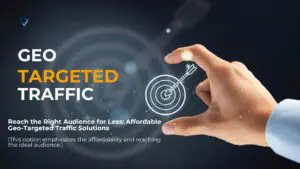
Contents
Organic vs Paid Traffic: A Guide To Understanding and Capitalizing
In the dynamic realm of online visibility, the battle between organic and paid traffic remains a pivotal aspect of digital marketing strategy.
As businesses strive to carve out their space in the digital landscape, understanding the nuances between these two traffic sources becomes essential for effective decision-making and maximizing online success.
Unraveling Organic Traffic: The Power of Sustainable Growth
1. The Essence of SEO:
Organic traffic for websites relies on Search Engine Optimization (SEO), emphasizing the importance of optimizing content, meta tags, and website structure to enhance visibility on search engine result pages (SERPs).
2. Trust and Credibility:
Organic results are perceived as more trustworthy by users, as they are not influenced by advertising budgets. Building trust through organic visibility is a key advantage.
3. Long-Term Impact:
While the results may take time to materialize, the sustainable growth provided by organic traffic becomes a long-term investment, paying dividends over an extended period.
4. Content Quality Matters:
High-quality, relevant content is the cornerstone of organic success. Search engines prioritize websites that offer valuable information to users, making content creation a strategic focus.
Deciphering Paid Traffic: Instant Visibility with a Price Tag
1. PPC Campaigns and Display Ads:
Paid traffic encompasses strategies like Pay-Per-Click (PPC) campaigns and display ads, providing businesses with immediate visibility on search engines and social media platforms.
2. Controlled Targeting:
Advertisers have precise control over their audience targeting, allowing for tailored campaigns based on demographics, interests, and behavior.
3. Flexibility and Adjustability:
Paid campaigns offer real-time adjustability. Advertisers can modify budgets, adjust ad creatives, and fine-tune targeting parameters on the fly, providing flexibility in strategy implementation.
4. Cost Factor:
Paid traffic operates on a cost-per-click (CPC) or cost-per-impression (CPM) model. The costs can vary based on factors such as ad placement, competition, and audience targeting.
Striking the Balance: Crafting a Holistic Approach
1. Synergistic Strategies:
The most successful digital marketing strategies often involve a synergy of both organic and paid approaches. Leveraging the strengths of each can create a well-rounded and effective online presence.
2. Understanding Audience Behavior:
Analyzing audience behavior and preferences helps in tailoring the balance between organic and paid efforts. Identifying the platforms where the target audience engages most is key.
3. Measuring and Optimizing:
Regularly measuring the performance of both organic and paid campaigns is essential. Analyzing key performance indicators (KPIs) enables ongoing optimization for better results.
4. Adapting to Industry Changes:
Given the ever-evolving digital landscape, staying abreast of industry changes, search engine algorithms, and user behavior is crucial for adapting organic and paid strategies accordingly.
Frequently Asked Questions (FAQs):
Q1: Which is better for immediate results – organic or paid traffic?
- Both have their advantages. Paid traffic provides instant visibility, while organic traffic offers sustainable, long-term growth.
Q2: Can I solely rely on organic traffic for online success?
- It depends on your goals and timeline. A balanced approach often yields the best results.
Q3: How long does it take to see results from organic efforts?
- Results can vary, but organic strategies generally take time to show significant impact.
Q4: What metrics should I track for paid campaigns?
- Key metrics include click-through rates (CTR), conversion rates, and return on investment (ROI).
Q5: Is SEO a one-time effort, or does it require ongoing attention?
- SEO is an ongoing process. Regular updates and optimizations are crucial for sustained success.
Q6: Can I use paid ads to enhance organic visibility?
- Yes, a strategic blend of paid and organic efforts can complement each other.
Q7: How do I identify the right keywords for SEO?
- Keyword research tools and understanding your target audience are key to identifying relevant keywords.
Q8: Are there industries where paid traffic is more effective than organic?
- It varies. Some industries may benefit more from immediate visibility through paid ads.
Q9: Can I switch between organic and paid strategies based on my business goals?
- Yes, flexibility is important. Adjust strategies based on immediate goals and overarching objectives.
Q10: Is social media part of organic or paid strategies?
- Social media can be part of both strategies. Organic involves regular posting, while paid includes sponsored content.
Q11: What role does content quality play in paid campaigns?
- Content quality is crucial for paid campaigns too. Engaging content enhances ad performance.
Q12: How often should I update my website for optimal organic performance?
- Regular updates, at least monthly, signal to search engines that your site is active and relevant.
Q13: Are there risks associated with relying solely on paid traffic?
- Yes, as costs can accumulate. A diversified strategy minimizes risks.
Q14: Can paid traffic be cost-effective in the long run?
- With strategic planning, paid traffic can offer a positive ROI over time.
Q15: Should I prioritize mobile optimization for both organic and paid strategies?
- Yes, given the rise in mobile users, optimizing for mobile is essential for both organic and paid success.
In conclusion, the interplay between organic and paid traffic is complex but critical for digital success. By understanding their unique characteristics and adopting a balanced approach, businesses can navigate the digital landscape strategically and capitalize on the strengths of both avenues. Additionally, exploring options like buying organic traffic can further enhance visibility and complement these efforts for a well-rounded online presence.






